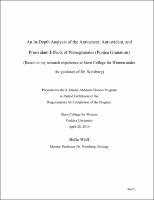Please use this identifier to cite or link to this item:
https://hdl.handle.net/20.500.12202/3998| Title: | An In-Depth Analysis of the Anticancer, Antioxidant, and Prooxidant Effects of Pomegranates |
| Authors: | Wolf, Bella |
| Keywords: | Punica -- Therapeutic use Cancer -- Prevention Cancer -- Nutritional aspects |
| Issue Date: | 28-Apr-2014 |
| Publisher: | Stern College for Women |
| Abstract: | One such ancient food, and perhaps arguably the most famously revered, is the pomegranate (Punica Granatum). This fruit, while perhaps less common nowadays in the average person’s daily diet, was commonplace in ancient times and has appeared in both a medicinal as well as spiritual context countless times. Punica refers to the city of Carthage, which provided Italy with some of the best pomegranates in ancient times, and Granatum means seedy due to the pomegranate’s large amount of seeds [1]. While the exact origins of the pomegranate may remain contested, it has been accepted that it was first seen in the Mediterranean and Near Eastern regions, which explains why its popularity and significance in ancient times resides in this area to the exclusion of Western Europe and the Americas [1]. Wolf!3 Further findings show that through trade the pomegranate has reached all corners of the world. One opinion is that it was originally cultivated, purportedly, in 3000 BCE in Iran, followed by 2000 BCE in North Africa, western Turkey, and Greece, 100 BCE in China, 800 CE in Spain, 1400 in Indonesia, and finally early 1700’s in the area now known as the United States of America [1]. |
| Description: | The file is restricted for YU community access only. |
| URI: | https://hdl.handle.net/20.500.12202/3998 https://ezproxy.yu.edu/login?url=https://repository.yu.edu/handle/20.500.12202/3998 |
| Appears in Collections: | S. Daniel Abraham Honors Student Theses |
Files in This Item:
| File | Description | Size | Format | |
|---|---|---|---|---|
| Bella Wolf-done.pdf Restricted Access | 688.94 kB | Adobe PDF |  View/Open |
This item is licensed under a Creative Commons License

